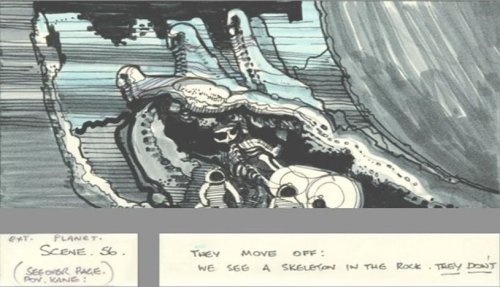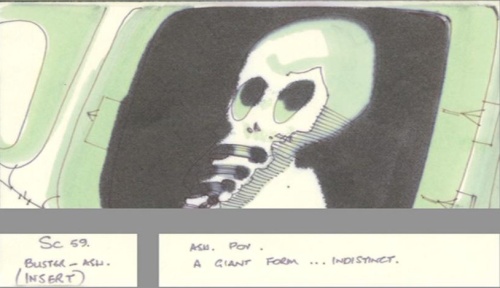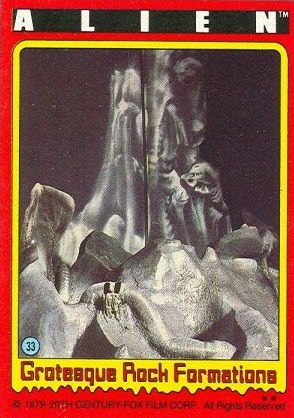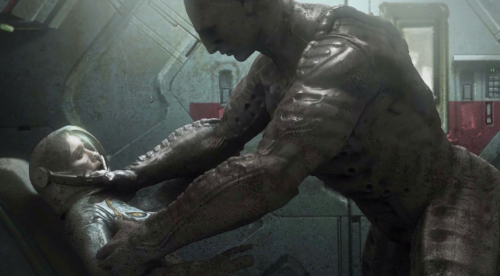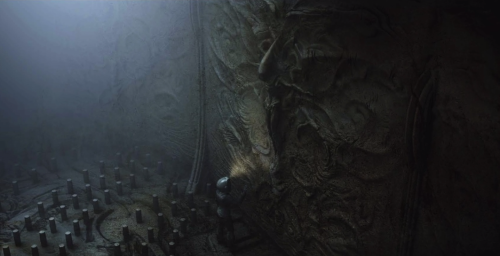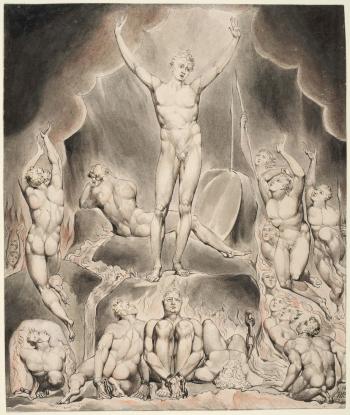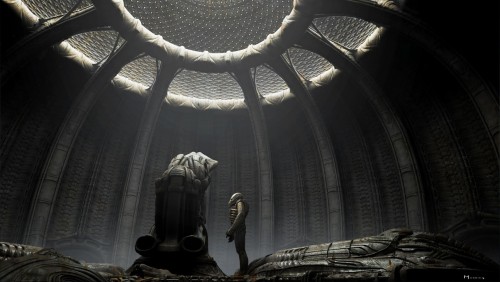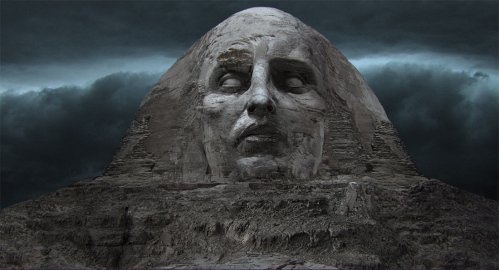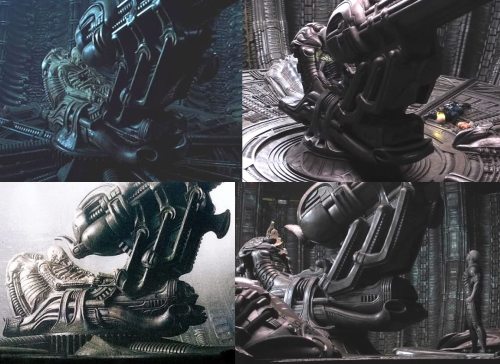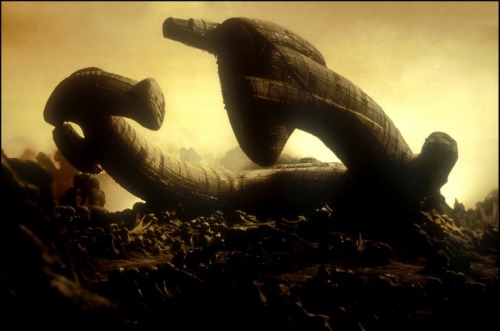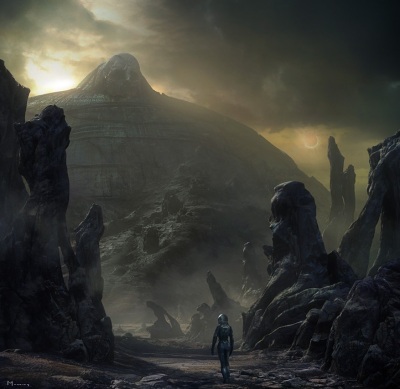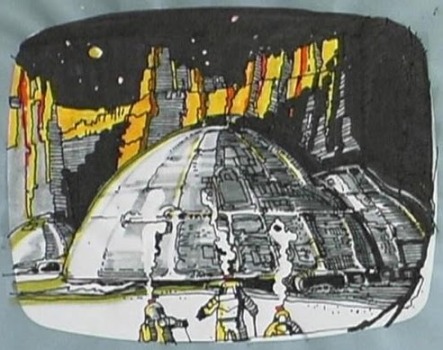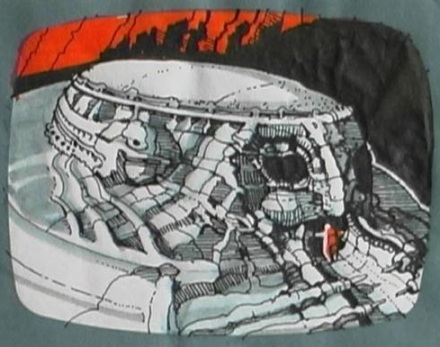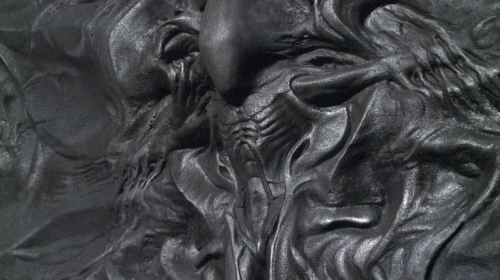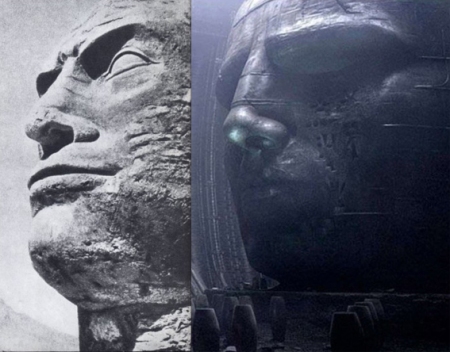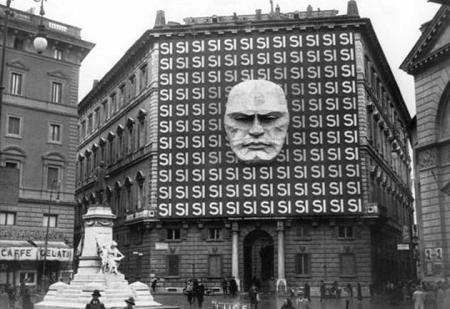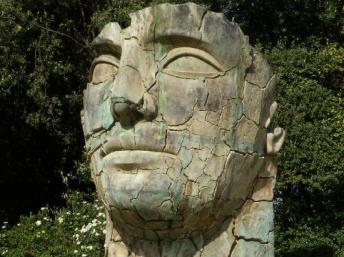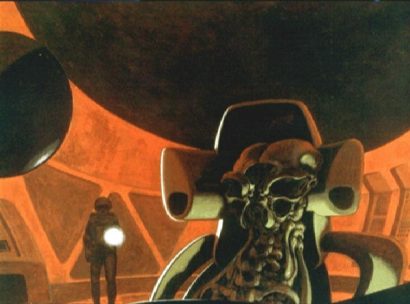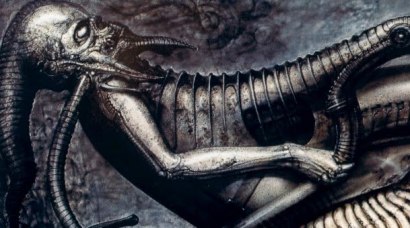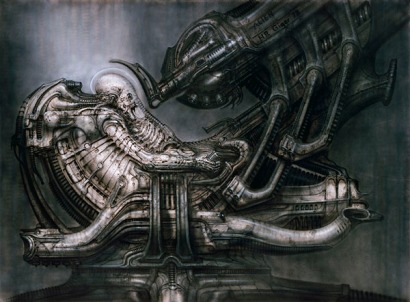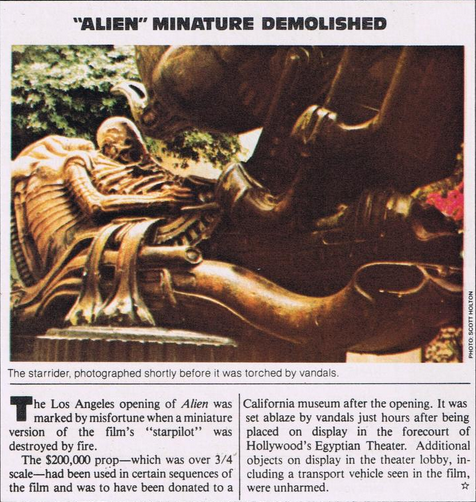
“Who, if I cried out, would hear me among the hierarchies
of angels? And if one did take
me to his heart: I would perish from his
stronger existence. For beauty is nothing
but the onset of terror we’re still just able to bear,
and we admire it so because it calmly disdains
to destroy us.
Every angel is terrifying.”
~ The First Elegy, Rainer Maria Rilke.
“They are men – and yet not men,” opens Jon Spaihts’ Alien prequel script. The scene is a primordial world, and three figures have walked out of the darkness… “Their skin is snow-white,” it continues. “Their features heavy and classical – as if Rodin’s Thinker had risen from his seat.” But it’s not Auguste Rodin’s masterpiece finally standing before us, it is HR Giger’s.
The origin of these pale giants harkens back to 1979’s Alien, which introduced us to the enigmatic and sessile Space Jockey. The Jockey had never figured into any of the Alien sequels, save for a brief mention in one draft of Aliens that went unfilmed. After a three decade absence the creature was back, though rebranded as the ‘Engineer’, an apparent biological warmonger, seeder of worlds and god-errant who, at some point in prehistory, created mankind.
Artist Neville Page was given the task of conceptualising the look of the Engineers. “We know that the Engineers were the engineers of us,” he elaborated, “but we don’t know, and nor can I speculate, why they left and came back and how many times they came back and what the intention was of returning and why they gave us the map to find them.”
“Their civilisation is millions of years old. Once, the Engineers expressed themselves as humans do, taking pleasure in music, colour and story, but they’ve long learned to see in more dimensions than we do. Their art and ornament exist on planes imperceptible to human senses. Their constructions look dark and grim to us; but the Engineers’ eyes see far more than our own. Individual Engineers live for a hundred thousand years. Ages ago their race abandoned sex and gender, reproducing by more abstract methods. In recent millenia they have ceased to reproduce altogether.”
~ Jon Spaihts’ “Alien Master Narrative”, script notes.
“When Shaw and Holloway conceived the mission, their expectation was they would discover a benevolent species that might provide answers to some of our greatest mysteries. In other words, they were hoping to meet gods. But these beings prove to be anything but compassionate. They are a dangerous race of superbeings.”
~ Michael Ellenberg (executive producer), screenslam, 2012.
As for the look of the Engineers, they “were an exercise in classic human beauty,” he explained. “Ridley was quite specific about his references of Roman and Grecian sculpture. ‘God-like, classical, powerful, with skin like that of stone’. In some ways, it was the easiest to design as there was little to do in terms of invention. In other ways, it was very difficult as the pursuit of human beauty is quite subjective.”
The most controversial aspect of the Engineer however was his relationship to the Space Jockey, ie: the Jockey was only one component of this gargantuan being; a suit or instrument. The real creature lay within.
“The giant [in Alien] was conceived as a skeleton,” Ridley Scott admitted. “I kept staring at the skeleton … then I thought, twenty, thirty, actually twenty six years on, ‘what if this is not a skeleton, but we only see it as a skeleton because of our own indoctrination?’ and I thought, ‘what happens if it’s another form of protection, or a suit? If it’s a suit, then what’s inside the suit?'”
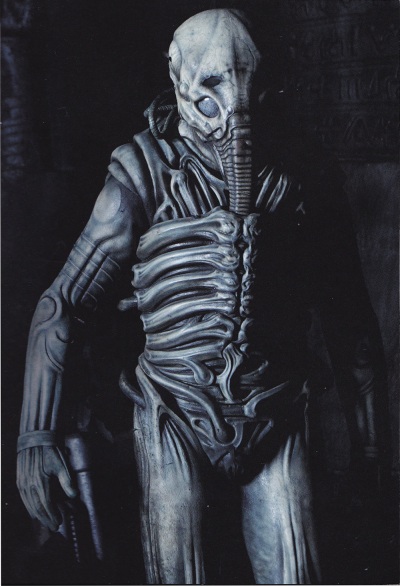
The Space Jockey recast as a biomechanical spacesuit. The ‘trunk’ is a breathing apparatus and the eye sockets are covered by lenses. The body is plated by a blue-grey coating. In the film the suits of dead Engineers have a more ossified look, like the Jockey of the original.
“It could be a degraded suit,” Scott says in Prometheus: The Art of the Film. “It’s only you saying that because you think you’re looking at bone structure and a ribcage. Why isn’t that a suit? It’s been lying there disintegrating for two or three thousand years in deep cold; that could be a suit. The suit works great as a kind of organic, very sophisticated spacesuit.”
“I think that was,” said Neville Page regarding the Space Jockey-Engineer, “and I’m guessing here quite honestly, that it was a bit of reverse engineering. I’m not sure how much Ridley knew when he was doing the first film that the elephantine face was going to be a helmet.”
Neville admitted that though they were retconning the original Space Jockey, it didn’t seem like a challenge to imagine that the ossified creature could be, essentially, a biomechanical life-support machine:
“It was a matter of shoehorning the Engineer into that device and being able to have him revealed so that he does look like the iconic Florentine sculptures that Ridley referenced in the ‘Art of’ book. Trying to have it be human yet knowing that that elephantine structure could not be a human head. It was pretty easy to just imagine that that’s some kind of specialized space helmet shell device.”
Creature conceptual artist Carlos Huante also provided designs for the Engineers, though he was not entirely satisfied with the end result: “I wasn’t entirely happy with the Engineer design” he told AVPGalaxy. “I thought it was great in theory but I thought it was going to be very difficult in application. And then after the design was settled on, we discussed the fabrication issues I foresaw. I predicted that the Engineers could end up looking fat or thick with bellies if they added too much rubber build up for the suit. Then the costume over all that rubber I thought they’re going to look fat for sure, which they did. So… There’s that.”
The Engineer was also originally planned to match the gargantuan height of the original Space Jockey. Jon Spaihts’ script takes a close look at one Engineer corpse, revealing that: “If he were standing he would be fifteen feet tall. He is roughly human in shape. Barrel-chested. Withered to the bone. There are bulky protrusions fused with his flesh: hard to say whether they are equipment or parts of his body. His head, lolling to one side, is severed from his body.” The Engineer was later shortened to make him practical to shoot on film, and for an actor to portray convincingly.

An Engineer design by Carlos Huante.
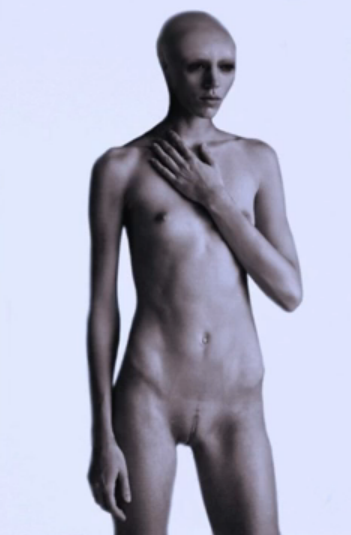
A hermaphroditic concept piece.
“I still was,” said Page, “where appropriate, channeling Giger’s work and Giger’s aesthetic, particularly with the Engineer’s spacesuit because it had to be that aesthetic. It was interesting because Ridley did say, ‘I don’t necessarily want to see you copy Giger’s work. That’s not what we’re doing here.'”
“I don’t like to repeat myself,” Scott offered as way of explanation. He was happy to use Giger’s aesthetic but keen to marry it to other influences. “In discussing it,” explained Page, “it was clear though that the Engineer was a Space Jockey, sitting inside of that vessel … The ironic thing is I didn’t open one Giger book. I didn’t look at his work, mainly because his work I’ve been looking at for years, since the original Alien and I’ve been a huge fan of it. So it was pretty deep in my mind and it was clear enough that I could actually replicate that aesthetic without having any of his artwork in front of me.”
Page referred to the biological suit as being “truly Giger”, but explained that the Engineers required “some kind of undersuit” which he was to design. “I started off just by doing basically underpants on the engineer with this exposed body. Then we realized he should probably not be as naked. If you were in a cryo chamber over years, you’d probably be in some kind of suit that could connect with your body tissue, protect it, monitor it, etc.”
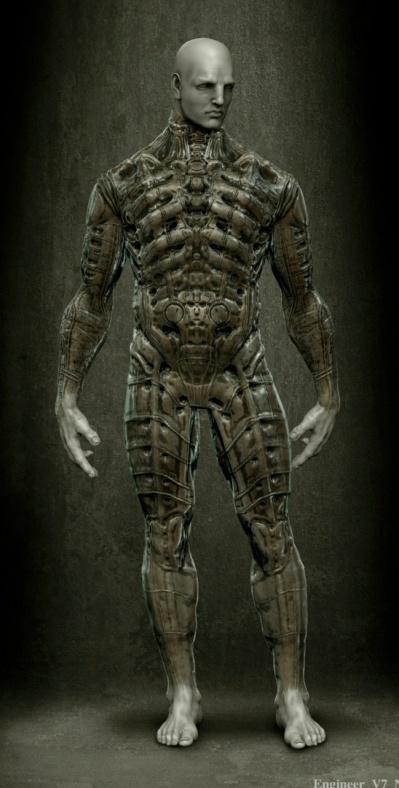
The Engineer wearing his ‘skin-suit’.
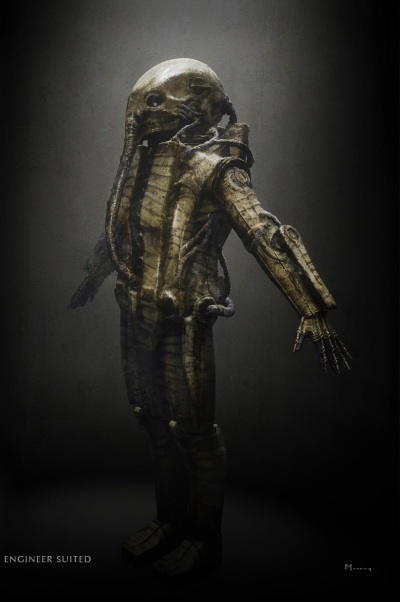
The Engineer in his ‘flight-suit’.
For the unsuited Engineers, Ridley Scott also invoked the fallen angels of John Milton’s Paradise Lost. “If you look at the Engineers,” said Scott, “they’re tall and elegant … they are dark angels. If you look at Paradise Lost, the guys who have the best time in the story are the dark angels, not God.”
Scott frequently alludes to the idea of Paradise as having sinister connotations. If we think in the vein of Milton’s Paradise Lost, the realm of heaven is presented as being authoritarian to an extreme, and more than capable of anticipating and destroying (or degrading) its enemies. In Milton’s tale Pandæmonium is the parliament of Hell, but Paradise’s power is far more terrible. “They’re going off to Paradise,” said Scott of the film’s two survivors, who leave LV-223 for the Engineer homeworld, “but it could be the most savage, horrible place.”
The Engineers in the film, then, are an amalgamation of Classical ideas of the heroic figure; Renaissance-era ideas about Heavenly and Hellish beings, and Giger’s signature biomechanics. All in all, it’s an enticing and interesting conglomeration of influences. The trouble would be not in selecting from differing artistic sources, but in melding and achieving equilibrium between them. On the one hand, the designs could be passed off as being generic if they conform too closely to an ‘ideal’ of the human figure: beautiful but blank. Marrying this aesthetic to biomechanics also has a shortfall: they simply may not be biomechanic enough; a bastardisation rather than a natural progression or offshoot.
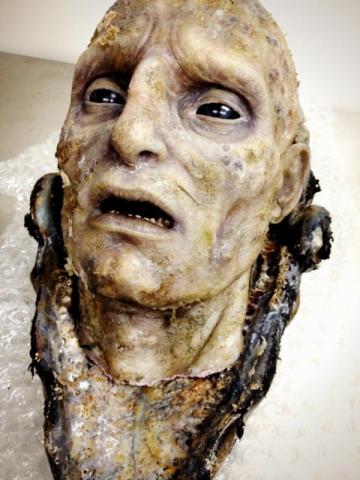
There are traces of biomechanical flourishes throughout the film’s designs. The decapitated Engineer’s helmet was to be like “cracking open an oyster” according to Neil Scanlan, and was sculpted with “castings from organic textures, including cabbages, cauliflower, and lichen. When the helmet opened, Ridley wanted the interior to be velvety and soft like the lining of a stomach, as if the helmet had nurtured the internal head with life-giving material.” One of Spaihts’ early scripts describes the Space Jockey’s suit as being welded to his body, flesh and machinery as one.
After Prometheus’ release many fans were disappointed that the motivations of the Engineers were not explained in the movie. As Ian Nathan said in his review at Empire Online: “[The Engineer] turns out to be an overly-pumped bald bloke with dead-eyes who has no dialogue and punches people across the room. So basically … God is Jason Statham.” Though the Engineer in the movie’s climax prefers to enunciate with his fists rather than his mouth, there are traces of motivation to be inferred… if we look beyond the film.
Engineering: In Jon Spaihts’ script it is revealed that the Engineers return to Earth every thousand years to ‘update’ their creations. “I was analysing historical changes in human DNA,” the script reveals through the character of Watts/Shaw. “I found the same pattern. Every eleven centuries, a pulse of new information in the genome of the human race. All over the world. Evolution can’t do that. Something was changing us. Changing the DNA of our species.”
This would have clarified why humans are so genetically close to the Engineers, whilst our Earthly cousins, such as other primate species, have taken another evolutionary path. Essentially, what makes the human race so unique among Earth-life is merely a helping hand.
At some point in the film’s development it was planned that the Engineers, the creators of humanity, were gearing up to destroy us for the crime of crucifying Christ, who was a representative of the gods. “We definitely did [plan that],” Scott told movies.com, “and then we thought it was a little too on the nose. But if you look at it as an ‘our children are misbehaving down there’ scenario, there are moments where it looks like we’ve gone out of control, running around with armor and skirts, which of course would be the Roman Empire. And they were given a long run. A thousand years before their disintegration actually started to happen. And you can say, ‘Lets’ send down one more of our emissaries to see if he can stop it.’ Guess what? They crucified him.”
It seems ridiculous to propose that a Jewish man at the time of Augustus and Tiberius was an eight-foot tall milk-white alien. Though some Biblical scholars posit that Christ, as characterised by St Paul in the earliest Christian texts, may have been an angelic or non-corporeal being, it is not a widely disseminated theory. If it’s difficult to convince some that Christ was not a man, it would be harder to convince audiences that he was an alien.
“We’re dealing with a highly hypothetical area in terms of who these beings are, what, if any invitation they issued, and who is responsible for making those cave paintings. And did something happen in between when those cave paintings were made -tens of thousands of years ago- and our arrival now, in 2093, 2,000 years after these things have perished. Did something happen in the intermediate period that we should be thinking about?”
~ Damon Lindelof, IGN, 2012
Again, Lindelof talks about something happening to sour the Engineers’ opinion of us. But with the Engineer Messiah scrapped, what was the motivation for the Engineers to destroy us? There seems to be none, but a potential answer, when considered, seems simple – the Engineers were afraid of humanity turning against them.
“The primary take away from the myth of Prometheus is that the Gods were nervous about mankind,” explained Lindelof. “They were nervous about what they would be capable of if they had fire. Fire was a big piece of technology that they would build off of.”
“Of wretched humans [Zeus] took no account,” explains the titan Prometheus in Aeschylus’ Prometheus Bound. “[He] resolved to eliminate them and create another race.” The only being who opposed Zeus’ genocide was Prometheus, who stole the secret of fire and delivered it to humanity. In the play, Prometheus presents himself not as the creator of mankind, but certainly their protector and teacher:
Chorus: What? Men, whose life is but a day, possess already the hot radiance of fire?
Prometheus: They do; and with it they will master many crafts … At first [they were] mindless, I gave them mind and reason. In those days they had eyes, but sight was meaningless; heard sounds, but could not listen; all their length of life passed like shapes in dreams, confused and purposeless.”
Prometheus’ gift allows humanity to better understand the world: they domesticate livestock, build ships and chariots, craft medicines, categorise all the beasts in nature, and master the art of prophecy. “So,” Prometheus concludes, “here’s the whole truth in one word: all human skill and science was Prometheus’ gift.”
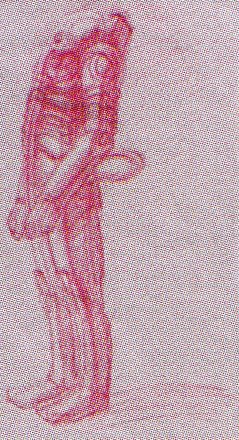
In the movie the Prometheus figure is represented by Weyland. Fire is certainly represented by technological marvels such as David. “Fire is our first form of technology,” Ridley told The Wall Street Journal. He also praised the simple-but-monumental central plot of Quest for Fire: “That was one of the most genius, simplistic but incredibly sophisticated notion of what [the first technological progression] was … And that got me sitting back on my ass thinking, ‘Damn! What a fundamentally massive idea'”.
In Prometheus fire is at this point in history superceded by robotics. To the Engineer, David is confirmation that mankind itself has become a creator of life, the very role for which the Engineers themselves are so vaunted. When your creations begin to construct other beings in their image, and can tailor these new life-forms to their needs, then it’s obvious that the creation has become the creator – it has become God. A key lesson in Paradise Lost is that God is, of course, unwilling to be usurped.
“Slaves! Scoff not at my will!
The mind, the spirit, the Promethean spark,
the lightning of my being is as bright,
pervading, and far-darting as your own,
and shall not yield to yours, though coop’d in clay!
Answer, or I will teach you what I am.”
~ Manfred challenges the Gods, Manfred, Lord Byron.
Lindelof explained that, “The idea that Ridley was advancing for Prometheus was, A) what if those things weren’t as alien as we thought they were? And, B) what if there is a fundamental relationship between those beings and us? And, C) what if they weren’t victims of these eggs but were directly responsible for making them? As in, it’s more of a thing where they made Pandora’s Box and something got out, rather than them being innocent, hapless victims.”

Humanity, as far as the film’s final Engineer is concerned, is simply another monster unleashed from Pandora’s Box, and needs to be contained or eliminated.
“[We looked at Prometheus as] an archeology dig,” Lindelof told The Hollywood Reporter, “where we’re basically going to turn up some artifacts and we’re going to put them on the table for everyone to look at. How these artifacts necessarily connect to each other and what the larger story behind them is going to be a matter of some discourse, and the characters in the movie will be having that discourse amongst themselves. But no one’s going to basically come out of the skies and tell them whether or not they’re right or wrong. That is very much in tune with the movie that Ridley wanted to make, which is, ‘This is what happens when mankind is silly enough to think they can go and ask God questions.’ First off, God might not necessarily be interested in answering you, but even worse than that, you might just set him off just for the act of trying.”
So, just as the characters in the film discover that ‘God’ is unwilling to explain himself, the fans of the film discover that it is also equally unwilling. It seems like a cruel joke that can amuse only its hardest of fans after the first telling, but I think that this is an unintended result, rather than a deliberate expectation. There are ways to reveal a secret to a viewer without giving the characters an epiphanic moment (Citizen Kane‘s final shot is a famous one) but Prometheus prefers to keep us pondering.
“That’s the fun of watching all the people rave lovingly and hatefully about it,” Neville Page told CraveOnline. “I don’t think you ever want people to go, ‘Yeah, it was okay’, in that gray zone. It’s like love me or hate me, but if you’re talking about me, that’s a good thing.”
“I think that Prometheus wanted to have two children. One child grows up to be Alien, the other child grows up to become this other mysterious force where we’re heading off in a different direction and contemplating why it is our creators wanted to destroy us. This is a fundamentally interesting question looked at on a theological level, but also on a sci-fi level as well.
In constructing those questions, Ridley wanted to know what the answers were as well, and we talked about those at great length, and then he determined what it was he wanted to put in the movie. I think that we had a very defined idea of why the Engineers put those paintings on cave walls, and why it is that they loaded ships full of death, as Shaw puts it at the end of the movie. So those answers are not definitively presented in Prometheus, though if you look through all the materials, I think that the evidence is all there to form a very informed opinion as to what happened, but I’m not going to tell you what my opinion is, as frustrating as it might be.”
~ Damon Lindelof, IGN, 2012
Related articles
Engineer Architecture & The Engineer Mythos


